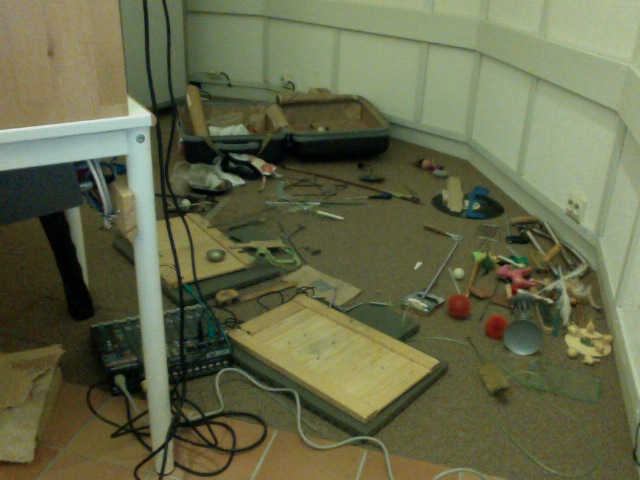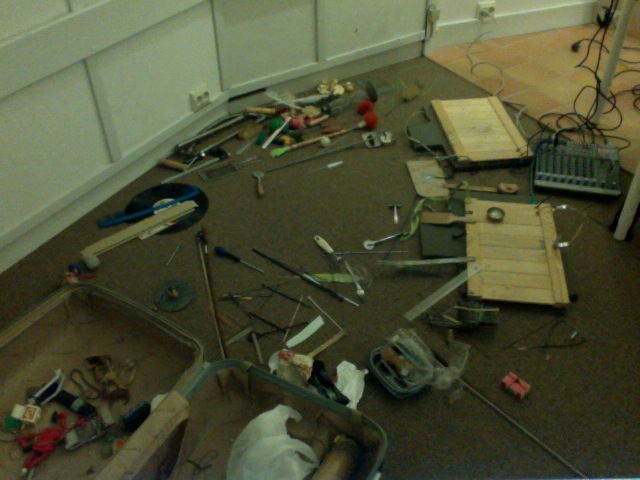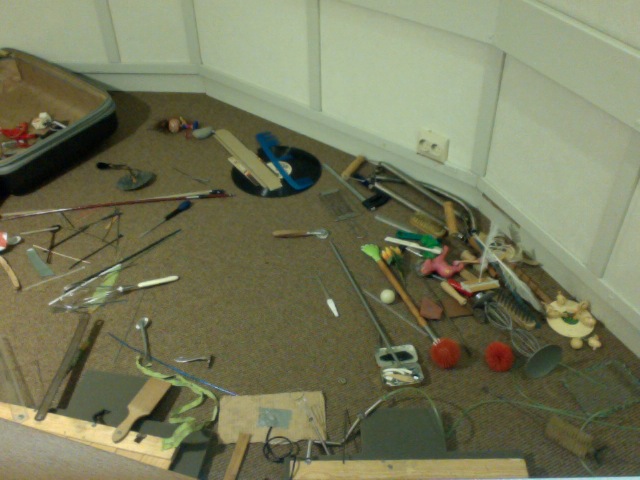
|
Text: Gösta Kriland (1917-1989)
Music: Johannes Bergmark Instrument: Platforms, contact-miked objects  Recorded at EMS, Stockholm 2011.
Recorded at EMS, Stockholm 2011.
Voices: Johannes Bergmark, Lily Bigestans, Magnus Johansson, Hanna Olivegren Wessblad, Marie Selander, Kent Tankred (First names' initials marked in the appropriate part) First performance: Friday, 4 November 2011 at the festival VINDÖGA 11, Sandvikens konsthall och Folkbibliotek
[I won't attempt any translation at this point.]
Vedbodens fossila livsormar,
Sågbockar galonerar
Huggkubbens passiar
Sågklingans styvna höstvin. Yxeggen
Something about Gösta Kriland (swedish).
Kriland became a member of “imaginisterna” in the 40ies.
At "Expo Aleby" in Stockholm, which was organized by Wilhelm Freddie, Ilmar Laaban and Gösta Kriland in March 1949, they participated as “individual artists”. This was the biggest surrealist exhibition in sweden until then.
“1954 Dick and I went on an evening course in drawing for Gösta Kriland, who did drawings in the old magazine Folket i Bild.
After this first surrealist-oriented period, however, he became known as an illustrator without a specifically surrealist vein, and he would later describe this part of his life, linked to his second marriage, as a long unhappiness.
Ragnar von Holten – Den okände Kriland (The Unknown Kriland) on Kaleidoskop förlag 1980 “describes Kriland's less known side: the experimenting and imaginative painter.”
His poetry production originates most of all from the 80ies, a time when he also became more productive in his surrealist image production. Some of his poems from that time were published in Kvicksand, the journal of the surrealist group 1989, the same year Gösta died. Here they can be read (swedish).
Here are some more poems by Gösta Kriland, from the posthumous book Det gåtfulla har ingen dörr (The Enigmatic Has No Door), Ellerströms förlag 1999.
Mattias Forshage has, in an essay about surrealist poetry in sweden also payed attention to Gösta Kriland in a section, and the same excerpts as in the two links above are there as well. Read it here (swedish).
He also made a thorough history of surrealism in sweden (in english), where Kriland is included as a central actor in his early as well as in his late periods. Part one is here and part two here.
The young surrealist group in the 80ies got in touch with Kriland, who, as far as his abilities allowed him, participated in the group's activities and games and contributed to our magazines. In spite of his dying body, he had a strongly vitalizing function on us, and we had meetings in his home on Tegnérgatan 48 (a couple of years earlier, 1985-86, I had stayed just two floors above him in the same estate without knowing about his existence) where we, among other things, talked about the creative and inciting power of confusion. A big teddy-bear always had an honorary place on a seat of its own. Darkness fell without anyone wanting to turn on the light. He talked about the decay of his own body and the strange “grains” that the doctors found in him as if it was a fascinating natural phenomenon or any mythical world. He developed the idea of the Desintegrator, a sort of destruction machine with a mystical function that we developed into a game in order to find out which parts it consisted of and what those did. He gave us copies of a couple of poems that I think we were using, among other things, as points of departures for associative games. These texts were among the most inspiring I have read in the swedish language. Together with the sound poems (which he explicitly call them) of Ilmar Laaban, I also regarded Gösta's poems as sound poetry. After his death my wish grew to present them in this light somehow. When I eventually, in the circumstances of a move 2011, found two poems on old stencils in the attic, I regained the wish to carry through this project, and used the Vindöga festival in Sandviken as an opportunity to give myself a deadline.
I didn't want to use only my own voice, and not too much sounds that could disturb the text contents. To give the text more levelling, I invited friends that have pleasant, deep voices without too far-out dialects or accents. These complement my own voice in fantastic ways that I couldn't have achieved on my own. To further advance the text, I let the voices repeat themselves and answer each other, sometimes nag and sometimes talk in choirs as it fell into place intuitively, and approximately in the way you might do when you read poetry on your own.
I started with the text above, and will eventually continue with the other (the voices are already recorded by the same people). In the work with the texts, I discovered that the many strange words that occur aren't Gösta's inventions as I had thought, but just unusual words. I don't know how he uncovered them, if he collected words he came about or actively looked them up in dictionaries or other sources. I present some dictionary explanations (on the swedish version of this web page) since I think they can give some extra depth to the poem, but if the listener prefers it that way, she can ignore that.
I also discovered that the poem had a sort of theme and a sort of form and rhythm. Theme as well as rhythm have given me suggestions about which kinds of sounds that can fit, and when they should come. It seems to have become a sado-masochistic rural carpenter's workshop of sorts. |
|



